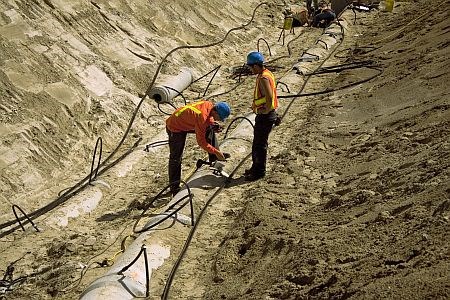While other companies worry about wasting energy, the team at the Sudbury-based Renewable Resource Recovery Corp. is fine with seeing it go down the drain – literally.
Of course, it’s only because they can take it back with their @Source-Energy Pipe, a special reinforced pre-cast concrete storm or sanitary sewer pipe capable of recovering the heat of whatever flows through it.
“It’s virtually a risk-free application, because both technologies are known,” says Boris Naneff, president of Renewable Resource Recovery Corp.
“Sewer pipes are known and are pre-qualified, and geothermal technology is also known and pre-qualified. We just put the two together.”
The specialty pipe has caught the eye of the industry, garnering a “specialty concrete products” award at the 2009 Ontario Concrete Awards, held in Toronto’s Convention Centre on Dec. 2.
If there’s one thing Naneff knows well, it’s concrete pipes. He also serves as the president of Rainbow Concrete, which manufactures the @Source-Energy product.
Naneff is willing to walk the talk, having installed the @Source Energy Pipe not only for his own home, but also throughout his 18-lot Garson subdivision, Naneff Gardens, as a pilot project.
Since connecting one home to the system is the carbon equivalent of taking three cars off the road, this subdivision virtually removes 54 cars off city streets, he says.
The environmental issue was one that helped drive the concept in the first place, sparked after Naneff met founding directors and former Cambrian College green educators Les Lisk and John Hood at Cambrian’s annual Living Building Conference. A chance meeting at another green energy conference brought one more person to the team, Toronto-based energy consultant Robert Mancini, who has 35 years of experience in geothermal energy design.
Together, the four devised a system where high-density tubing is wrapped around the wire mesh that forms the core of the pipe, which is then encased in concrete. A mixture of water and ethanol in the tubing absorbs the thermal heat from the surrounding earth, as well as the effluent in the concrete pipe itself.
The system is connected to a geothermal heat pump in the building, which replaces a standard furnace. This extracts the heat from the liquid, which sits between 40 and 50 degrees Fahrenheit and expands it to reach standard room temperatures.
Because of the small 20-degree temperature difference between the two, very little energy is required to heat a home with this system, creating efficiencies of up to 500 per cent. This means homeowners will get up to five dollars of energy for every dollar of electricity they put in, potentially saving 25 per cent on their annual bill.
Concerns surrounding the shared connection to a sewer system are often unfounded, says Hood, since each home is on its own independent system.
“People see the sewer pipe going down the street and think that all the homes are connected, so if one has a problem, the neighbor’s got a problem,” says Hood. “But no, we’re just tapping the heat out of the sewer pipes, and each home has its own unit of sewer pipe.”
The product is designed so it is capable of drawing heat out of a home and pushing it back into the system during warmer weather, effectively cooling the building.
This dual use makes it well adapted for almost any climate, says Naneff. Queries have already begun to pour in from around the globe, with serious discussions taking place with companies in the United States and eastern Canada.
The market is wide open, says Lisk. While retrofitting a home with the @Source-Energy Pipe may initially seem less than practical, there are plenty of other opportunities, such as when cities change out aging sewer infrastructure or a developer sets up a new subdivision.
He even suggests that cities could find a way to charge homeowners for the heating provided through these systems, offsetting the cost of installation and deflating the need for an increase in municipal taxes. This would also keep much of Sudbury’s combined $300-million annual energy spending within the community, he says.
Given the sheer weight of concrete, it’s likely the team will begin licensing the concept to other companies rather than attempt to ship products manufactured in Sudbury to concrete manufacturers and energy providers around the world.
The owners’ dreams of seeing a use for their product beyond residential housing received a boost after being been approved by the province as being qualified for its Green Schools Pilot Initiative. This opens up their product for use in the construction of Ontario schools, which are being encouraged to purchase and test various green technologies.
The concept behind the product is already being adapted to other uses, including a precast wall armed with photovoltaic panels, absorbing solar heat and uses it in much the same way as the @Source Energy Pipe. This system is being touted for use in new construction and even as cladding on existing buildings.
“There’s a much stronger awareness for this kind of thing now than there was three or four years ago, that’s for sure,” says Naneff.
www.rcil.ca
www.smsrents.com
www.moneyinmotioninc.com




